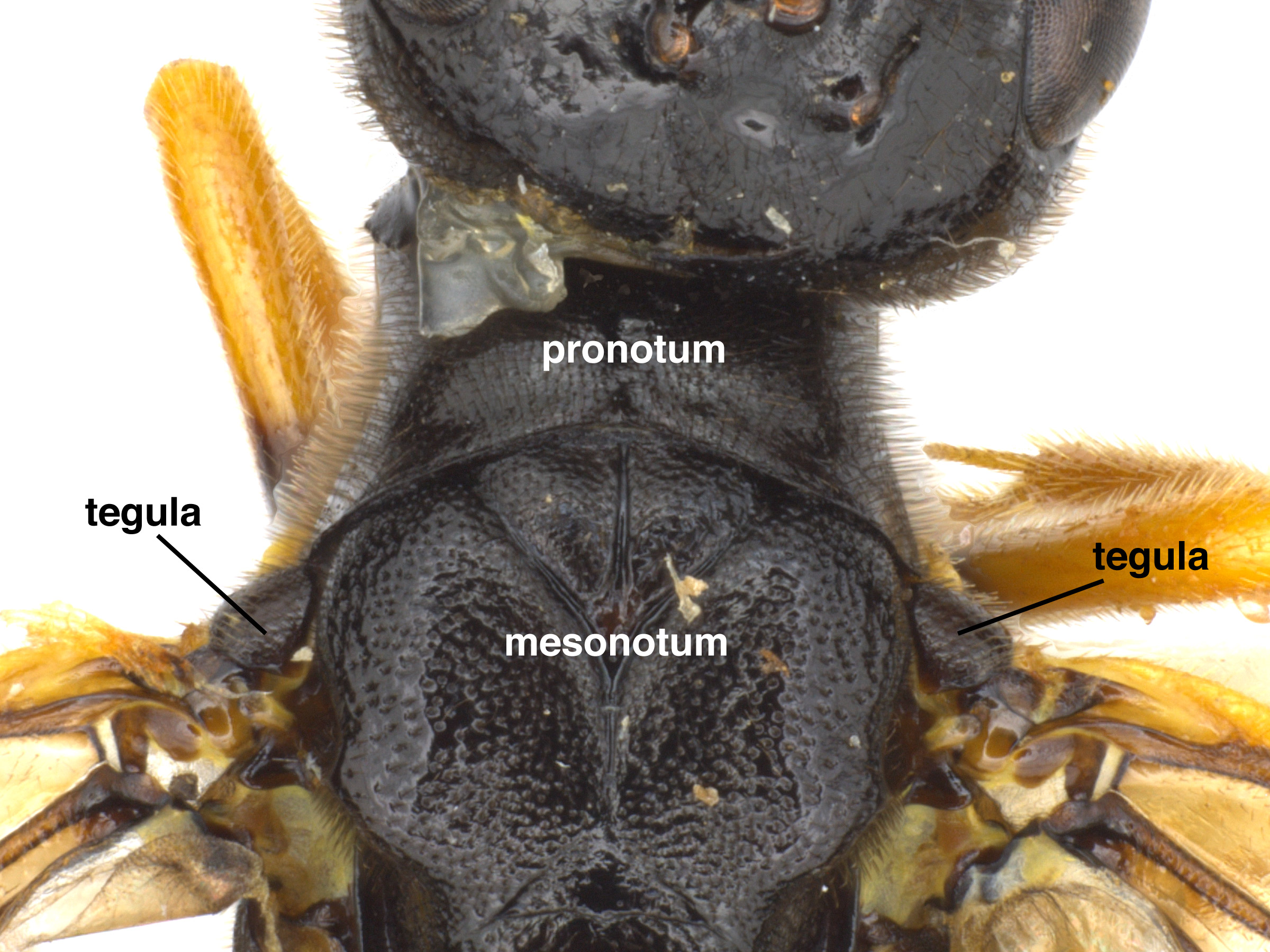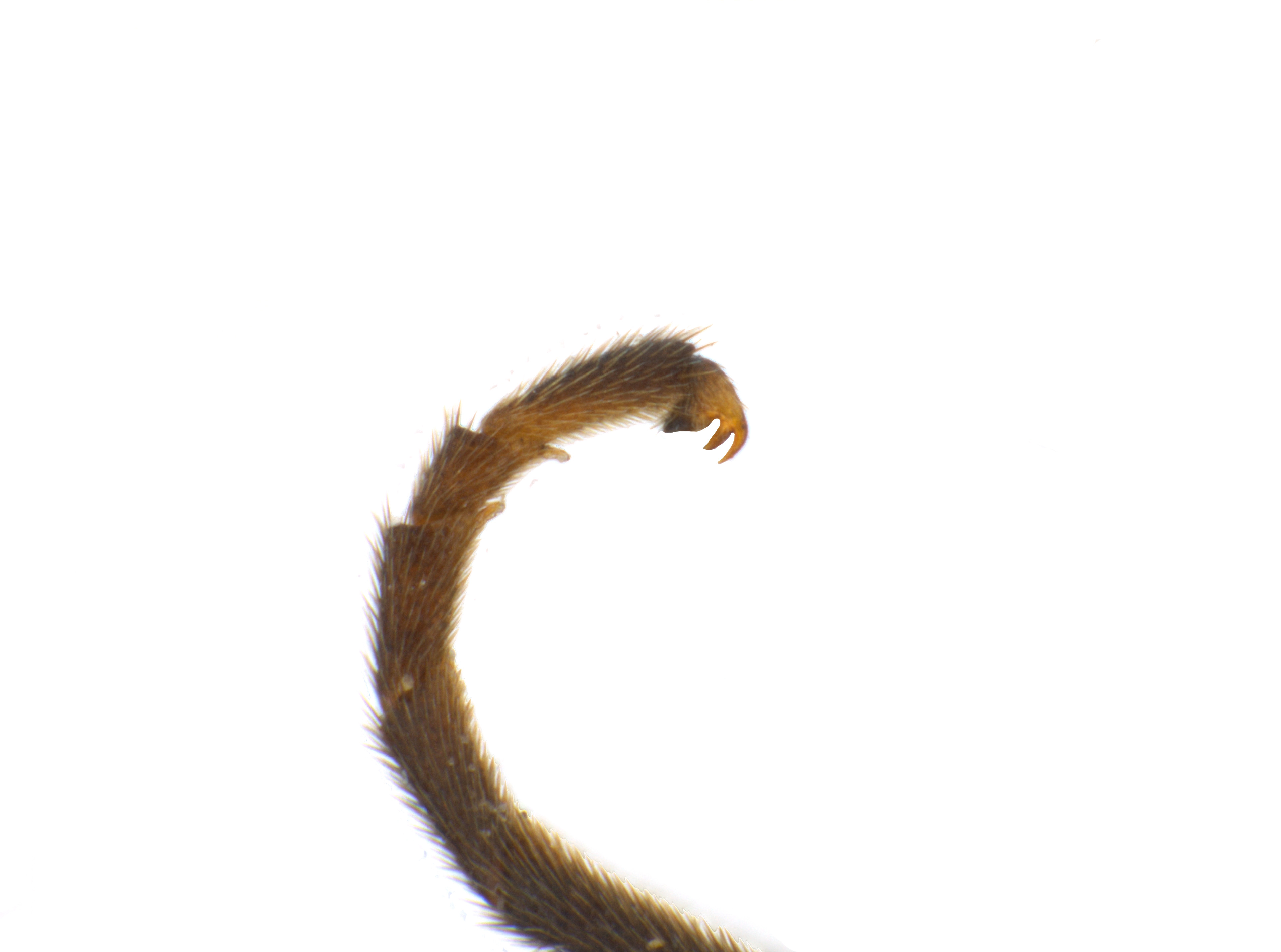Family: Tenthredinidae
Family common name: common sawflies
Subfamily: Allantinae
Tribe: Empriini
Genus: Aphilodyctium Ashmead, 1898
Subgenera: none
The Tenthredinidae are the most species-rich family and are found throughout the world, in all continents but Antarctica. They are known as the “common sawflies.” They can generally be recognized by a cylindrical body and long, segmented antennaeantenna:
the sensory organ emerging from the front of the head, usually between the compound eyes and above the clypeus; includes the flagellum, scape and pedicel
 . Otherwise, they come in a variety of colors, sizes, and forms (Goulet 1992Goulet 1992:
. Otherwise, they come in a variety of colors, sizes, and forms (Goulet 1992Goulet 1992:
Goulet H. 1992. The genera and subgenera of the sawflies of Canada and Alaska: Hymenoptera. Symphyta. The insects and arachnids of Canada. Part 20. Agriculture Canada Publication.).
Sawflies in the Allantinae subfamily are mostly black and shining, sometimes with other colors. They have agricultural importance as some species are pests on cultivated and ornamental plants (Smith 1979aSmith 1979a:
Smith DR. 1979a. Nearctic sawflies. IV. Allantinae: Adults and larvae (Hymenoptera: Tenthredinidae). Technical Bulletin, U.S. Department of Agriculture 1595: 1-172.). They can be distinguished from other subfamilies by wing venationvenation:
the network of veins on a wing
(Smith 2003aSmith 2003a:
Smith DR. 2003a. A Synopsis of the sawflies (Hymenoptera: Symphyta) of America south of the United States: Tenthredinidae (Allantinae). Journal of Hymenoptera Research 12 (1): 148-192.).
Aphilodyctium are medium-sized, about 7–8 mm in length. There is a single North American species, A. fidum, and it is recognized by mostly orange legs, orange and black abdomenabdomen:
the third and last segment of an insect's body; in sawflies this is usually made up of 11 segments (segments 9 and 10 often fused) , and white tegulaetegula:
, and white tegulaetegula:
a thin, plate-like structure emerging from the base of the fore wing
 (Smith 1979aSmith 1979a:
(Smith 1979aSmith 1979a:
Smith DR. 1979a. Nearctic sawflies. IV. Allantinae: Adults and larvae (Hymenoptera: Tenthredinidae). Technical Bulletin, U.S. Department of Agriculture 1595: 1-172.).
There is one described extantextant:
in existence; opposite of extinct
species worldwide, and it is NearcticNearctic:
describing the region of the Northern Hemisphere that includes North America south through northern Mexico
 (Taeger et al. 2010Taeger et al. 2010:
(Taeger et al. 2010Taeger et al. 2010:
Taeger A, Blank SM, and Liston AD. 2010. World Catalog of Symphyta (Hymenoptera). Zootaxa 2580: 1-1064.).
A NearcticNearctic:
describing the region of the Northern Hemisphere that includes North America south through northern Mexico
 key to species is included in Smith 1979aSmith 1979a:
key to species is included in Smith 1979aSmith 1979a:
Smith DR. 1979a. Nearctic sawflies. IV. Allantinae: Adults and larvae (Hymenoptera: Tenthredinidae). Technical Bulletin, U.S. Department of Agriculture 1595: 1-172..
Subfamily characters
 vein M and 1m-cu parallel (Smith 1979aSmith 1979a:
vein M and 1m-cu parallel (Smith 1979aSmith 1979a: vein 2A+3A complete, connected to 1A by crossveincrossvein:
vein 2A+3A complete, connected to 1A by crossveincrossvein:Genus characters
 (Smith 1979aSmith 1979a:
(Smith 1979aSmith 1979a: moderately notched; circularly emarginated (Smith 1979aSmith 1979a:
moderately notched; circularly emarginated (Smith 1979aSmith 1979a: vein 2r present (Smith 1979aSmith 1979a:
vein 2r present (Smith 1979aSmith 1979a: vein M intersecting Sc+R at the intersection of Sc+R and Rs+M (Smith 1979aSmith 1979a:
vein M intersecting Sc+R at the intersection of Sc+R and Rs+M (Smith 1979aSmith 1979a: with indistinct basalbasal:
with indistinct basalbasal: (Smith 1979aSmith 1979a:
(Smith 1979aSmith 1979a:Aphilodyctium can be confused with similar species in the subfamily Allantinae or tribe Empriini. It can be distinguished from most other genera by the circular clypeusclypeus:
sclerotized area on the front of the head located between the antennal insertions and labrum
 emargination and the lack of cellcell:
emargination and the lack of cellcell:
1. a membranous area of the wing between veins, 2. a small cavity or closed space
 M in the hind winghind wing:
M in the hind winghind wing:
the posterior wing of each pair of wings
 (Smith 1979aSmith 1979a:
(Smith 1979aSmith 1979a:
Smith DR. 1979a. Nearctic sawflies. IV. Allantinae: Adults and larvae (Hymenoptera: Tenthredinidae). Technical Bulletin, U.S. Department of Agriculture 1595: 1-172.).
none
In North America, A. fidum feeds on Rosa spp. (rose) (Smith 1979aSmith 1979a:
Smith DR. 1979a. Nearctic sawflies. IV. Allantinae: Adults and larvae (Hymenoptera: Tenthredinidae). Technical Bulletin, U.S. Department of Agriculture 1595: 1-172.).
Specific biology for A. fidum is not known. LarvaeLarva:
the immature stage of holometabolous insects
 have been observed on the host plant. Adult A. fidum have emerged from a variety of plants other than the host, suggesting that the prepupae build cells to overwinter in secondary host plants, similarly to Ametastegia. Aphilodyctium fidum is univoltineunivoltine:
have been observed on the host plant. Adult A. fidum have emerged from a variety of plants other than the host, suggesting that the prepupae build cells to overwinter in secondary host plants, similarly to Ametastegia. Aphilodyctium fidum is univoltineunivoltine:
describing an insect with a life cycle of one generation per year
(Smith 1979aSmith 1979a:
Smith DR. 1979a. Nearctic sawflies. IV. Allantinae: Adults and larvae (Hymenoptera: Tenthredinidae). Technical Bulletin, U.S. Department of Agriculture 1595: 1-172.).
World: This genus is known only from North America (Smith 1979aSmith 1979a:
Smith DR. 1979a. Nearctic sawflies. IV. Allantinae: Adults and larvae (Hymenoptera: Tenthredinidae). Technical Bulletin, U.S. Department of Agriculture 1595: 1-172., Taeger et al. 2010Taeger et al. 2010:
Taeger A, Blank SM, and Liston AD. 2010. World Catalog of Symphyta (Hymenoptera). Zootaxa 2580: 1-1064.).
North America: Aphilodyctium fidum is widespread in northern United States and southern Canada, as far south as California and Arizona in the west, North Carolina in the east (Smith 1979aSmith 1979a:
Smith DR. 1979a. Nearctic sawflies. IV. Allantinae: Adults and larvae (Hymenoptera: Tenthredinidae). Technical Bulletin, U.S. Department of Agriculture 1595: 1-172.).
Map data from: GBIF.org (29 October 2019) GBIF Occurrence Download Aphilodyctium
Details about data used for maps can be found here.